Fannie Mae 2010 Annual Report Download - page 7
Download and view the complete annual report
Please find page 7 of the 2010 Fannie Mae annual report below. You can navigate through the pages in the report by either clicking on the pages listed below, or by using the keyword search tool below to find specific information within the annual report.-
 1
1 -
 2
2 -
 3
3 -
 4
4 -
 5
5 -
 6
6 -
 7
7 -
 8
8 -
 9
9 -
 10
10 -
 11
11 -
 12
12 -
 13
13 -
 14
14 -
 15
15 -
 16
16 -
 17
17 -
 18
18 -
 19
19 -
 20
20 -
 21
21 -
 22
22 -
 23
23 -
 24
24 -
 25
25 -
 26
26 -
 27
27 -
 28
28 -
 29
29 -
 30
30 -
 31
31 -
 32
32 -
 33
33 -
 34
34 -
 35
35 -
 36
36 -
 37
37 -
 38
38 -
 39
39 -
 40
40 -
 41
41 -
 42
42 -
 43
43 -
 44
44 -
 45
45 -
 46
46 -
 47
47 -
 48
48 -
 49
49 -
 50
50 -
 51
51 -
 52
52 -
 53
53 -
 54
54 -
 55
55 -
 56
56 -
 57
57 -
 58
58 -
 59
59 -
 60
60 -
 61
61 -
 62
62 -
 63
63 -
 64
64 -
 65
65 -
 66
66 -
 67
67 -
 68
68 -
 69
69 -
 70
70 -
 71
71 -
 72
72 -
 73
73 -
 74
74 -
 75
75 -
 76
76 -
 77
77 -
 78
78 -
 79
79 -
 80
80 -
 81
81 -
 82
82 -
 83
83 -
 84
84 -
 85
85 -
 86
86 -
 87
87 -
 88
88 -
 89
89 -
 90
90 -
 91
91 -
 92
92 -
 93
93 -
 94
94 -
 95
95 -
 96
96 -
 97
97 -
 98
98 -
 99
99 -
 100
100 -
 101
101 -
 102
102 -
 103
103 -
 104
104 -
 105
105 -
 106
106 -
 107
107 -
 108
108 -
 109
109 -
 110
110 -
 111
111 -
 112
112 -
 113
113 -
 114
114 -
 115
115 -
 116
116 -
 117
117 -
 118
118 -
 119
119 -
 120
120 -
 121
121 -
 122
122 -
 123
123 -
 124
124 -
 125
125 -
 126
126 -
 127
127 -
 128
128 -
 129
129 -
 130
130 -
 131
131 -
 132
132 -
 133
133 -
 134
134 -
 135
135 -
 136
136 -
 137
137 -
 138
138 -
 139
139 -
 140
140 -
 141
141 -
 142
142 -
 143
143 -
 144
144 -
 145
145 -
 146
146 -
 147
147 -
 148
148 -
 149
149 -
 150
150 -
 151
151 -
 152
152 -
 153
153 -
 154
154 -
 155
155 -
 156
156 -
 157
157 -
 158
158 -
 159
159 -
 160
160 -
 161
161 -
 162
162 -
 163
163 -
 164
164 -
 165
165 -
 166
166 -
 167
167 -
 168
168 -
 169
169 -
 170
170 -
 171
171 -
 172
172 -
 173
173 -
 174
174 -
 175
175 -
 176
176 -
 177
177 -
 178
178 -
 179
179 -
 180
180 -
 181
181 -
 182
182 -
 183
183 -
 184
184 -
 185
185 -
 186
186 -
 187
187 -
 188
188 -
 189
189 -
 190
190 -
 191
191 -
 192
192 -
 193
193 -
 194
194 -
 195
195 -
 196
196 -
 197
197 -
 198
198 -
 199
199 -
 200
200 -
 201
201 -
 202
202 -
 203
203 -
 204
204 -
 205
205 -
 206
206 -
 207
207 -
 208
208 -
 209
209 -
 210
210 -
 211
211 -
 212
212 -
 213
213 -
 214
214 -
 215
215 -
 216
216 -
 217
217 -
 218
218 -
 219
219 -
 220
220 -
 221
221 -
 222
222 -
 223
223 -
 224
224 -
 225
225 -
 226
226 -
 227
227 -
 228
228 -
 229
229 -
 230
230 -
 231
231 -
 232
232 -
 233
233 -
 234
234 -
 235
235 -
 236
236 -
 237
237 -
 238
238 -
 239
239 -
 240
240 -
 241
241 -
 242
242 -
 243
243 -
 244
244 -
 245
245 -
 246
246 -
 247
247 -
 248
248 -
 249
249 -
 250
250 -
 251
251 -
 252
252 -
 253
253 -
 254
254 -
 255
255 -
 256
256 -
 257
257 -
 258
258 -
 259
259 -
 260
260 -
 261
261 -
 262
262 -
 263
263 -
 264
264 -
 265
265 -
 266
266 -
 267
267 -
 268
268 -
 269
269 -
 270
270 -
 271
271 -
 272
272 -
 273
273 -
 274
274 -
 275
275 -
 276
276 -
 277
277 -
 278
278 -
 279
279 -
 280
280 -
 281
281 -
 282
282 -
 283
283 -
 284
284 -
 285
285 -
 286
286 -
 287
287 -
 288
288 -
 289
289 -
 290
290 -
 291
291 -
 292
292 -
 293
293 -
 294
294 -
 295
295 -
 296
296 -
 297
297 -
 298
298 -
 299
299 -
 300
300 -
 301
301 -
 302
302 -
 303
303 -
 304
304 -
 305
305 -
 306
306 -
 307
307 -
 308
308 -
 309
309 -
 310
310 -
 311
311 -
 312
312 -
 313
313 -
 314
314 -
 315
315 -
 316
316 -
 317
317 -
 318
318 -
 319
319 -
 320
320 -
 321
321 -
 322
322 -
 323
323 -
 324
324 -
 325
325 -
 326
326 -
 327
327 -
 328
328 -
 329
329 -
 330
330 -
 331
331 -
 332
332 -
 333
333 -
 334
334 -
 335
335 -
 336
336 -
 337
337 -
 338
338 -
 339
339 -
 340
340 -
 341
341 -
 342
342 -
 343
343 -
 344
344 -
 345
345 -
 346
346 -
 347
347 -
 348
348 -
 349
349 -
 350
350 -
 351
351 -
 352
352 -
 353
353 -
 354
354 -
 355
355 -
 356
356 -
 357
357 -
 358
358 -
 359
359 -
 360
360 -
 361
361 -
 362
362 -
 363
363 -
 364
364 -
 365
365 -
 366
366 -
 367
367 -
 368
368 -
 369
369 -
 370
370 -
 371
371 -
 372
372 -
 373
373 -
 374
374 -
 375
375 -
 376
376 -
 377
377 -
 378
378 -
 379
379 -
 380
380 -
 381
381 -
 382
382 -
 383
383 -
 384
384 -
 385
385 -
 386
386 -
 387
387 -
 388
388 -
 389
389 -
 390
390 -
 391
391 -
 392
392 -
 393
393 -
 394
394 -
 395
395 -
 396
396 -
 397
397 -
 398
398 -
 399
399 -
 400
400 -
 401
401 -
 402
402 -
 403
403
 |
 |

Since our entry into conservatorship, we have entered into agreements with Treasury that include covenants
that significantly restrict our business activities and provide for substantial U.S. government financial support.
We provide additional information on the conservatorship, the provisions of our agreements with the Treasury,
and its impact on our business below under “Conservatorship and Treasury Agreements” and “Risk Factors.”
RESIDENTIAL MORTGAGE MARKET
The U.S. Residential Mortgage Market
We conduct business in the U.S. residential mortgage market and the global securities market. In response to
the financial crisis and severe economic recession that began in December 2007, the U.S. government took a
number of extraordinary measures designed to provide fiscal stimulus, improve liquidity and protect and
support the housing and financial markets. Examples of these measures include: (1) the Federal Reserve’s
temporary programs to purchase up to $1.25 trillion of GSE mortgage-backed securities and approximately
$175 billion of GSE debt by March 31, 2010, which were intended to provide support to mortgage lending
and the housing market and to improve overall conditions in private credit markets; (2) the Administration’s
Making Home Affordable Program, which was intended to stabilize the housing market by providing
assistance to homeowners and preventing foreclosures; and (3) the first-time and move-up homebuyer tax
credits, enacted to help increase home sales and stabilize home prices. The homebuyer tax credits were
available for qualifying home purchases by buyers who entered into binding contracts by April 30, 2010.
Total U.S. residential mortgage debt outstanding, which includes $10.6 trillion of single-family mortgage debt
outstanding, was estimated to be approximately $11.5 trillion as of September 30, 2010, the latest date for
which information was available, according to the Federal Reserve. After increasing every quarter since record
keeping began in 1952 until the second quarter of 2008, single-family mortgage debt outstanding has been
steadily declining since then. We owned or guaranteed mortgage assets representing approximately 27.4% of
total U.S. residential mortgage debt outstanding as of September 30, 2010.
We operate our business solely in the United States and its territories, and accordingly, we generate no revenue
from and have no assets in geographic locations other than the United States and its territories.
Housing and Mortgage Market and Economic Conditions
During the fourth quarter of 2010, the United States economic recovery continued. The U.S. gross domestic
product, or GDP, rose by 3.2% on an annualized basis during the quarter after adjusting for inflation,
according to the Bureau of Economic Analysis advance estimate. The overall economy gained an estimated
128,000 jobs in the fourth quarter, with the private sector continuing its recent trend of moderate employment
growth throughout the quarter and into January 2011. The unemployment rate was 9.0% in January 2011,
compared with 9.6% in September 2010, based on data from the U.S. Bureau of Labor Statistics.
Housing activity rebounded modestly in the fourth quarter of 2010 after experiencing a pullback in the third
quarter. For all of 2010, home sales declined for the fourth time in the past five years, despite low mortgage
rates, reduced home prices and the first-time and move-up homebuyer tax credits that increased existing home
sales earlier in the year. Weak demand for homes, a weak labor market, strengthened lending standards in the
industry and elevated vacancy and foreclosure rates are the main obstacles to the housing recovery. Total
existing home sales fell by 4.8% in 2010 from 2009, according to data available through January 2011. Faced
with fierce competition from distressed sales, new home sales fared significantly worse, dropping by 14.2% in
2010, according to data available through January 2011, and accounting for just 5.5% of total home sales in
the fourth quarter of 2010, down from a peak of more than 19% at the beginning of 2005. After four
consecutive years of double-digit declines to an annual record low, total housing starts rose a modest 5.9% in
2010.
2
